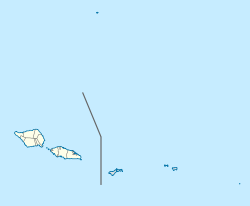Falealupo | |
|---|---|
Village & Electoral Constituency | |
 Falealupo sunset | |
 Main road in the afternoon, Falealupo Tai | |
| Coordinates: 13°30′9″S 172°47′23″W / 13.50250°S 172.78972°W | |
| Country | |
| District | Vaisigano |
| Population (2016) | |
• Total | 545 |
| Time zone | +13 |
| Falealupo-uta (inland) & Falealupo-tai (coast) | |

Falealupo is a village in Samoa situated at the west end of Savai'i island 20 miles (32 km) from the International Date Line used until 29 December 2011.[1] The village has two main settlements, Falealupo-Uta, situated inland by the main island highway and Falealupo-Tai, situated by the sea. The road to the coastal settlement is about 9 km, most of it unsealed, from the main highway. The village's population is 545.[2]
Due to its location in the west of the country, and because Samoa was just to the east of the International Date Line,[3] Falealupo has been described as "the last village in the world to see the sunset of each day". This has now changed, as the Samoan government has moved the International Date Line east of the country in 2011.[4]
Families have moved inland for the convenience of living by the main road near public transport, as well as the extensive damage to the coastal village from cyclones in the early 1990s, which left behind old church ruins along the coast. There are rock pools, caves, and sandy beaches in the area. Falealupo-Uta has small shops and facilities for Western Union money transfer while there are beach fale accommodation and a shop at Falealupo-tai.
The settlement is part of Falealupo Electoral Constituency (Faipule District) which forms part of the larger political district of Vaisigano.[5]
Roman Catholic Cardinal Pio Taofinu'u (1923–2006), the first Polynesian bishop and cardinal, was born in Falealupo and attended the village school.[6]
- ^ "A December day disappears in Samoa and Tokelau". stuff.co.nz. 21 December 2011.
- ^ "Census 2016 Preliminary count" (PDF). Samoa Bureau of Statistics. 2016. Retrieved 23 August 2021.
- ^ Samoa was just to the east of the International Date Line until 30 December 2011 at 10:00 UTC.
- ^ "Samoa and Tokelau to Cross Date Line Dec. 29". Time. 28 December 2011. Archived from the original on 29 December 2011. Retrieved 29 December 2011.
- ^ "Population and Housing Census Report 2006" (PDF). Samoa Bureau of Statistics. July 2008. Archived from the original (PDF) on 21 July 2011. Retrieved 19 December 2009.
- ^ "College of Cardinals Biographical Note". Holy See Press Office, Vatican. 21 January 2006. Retrieved 23 January 2010.
